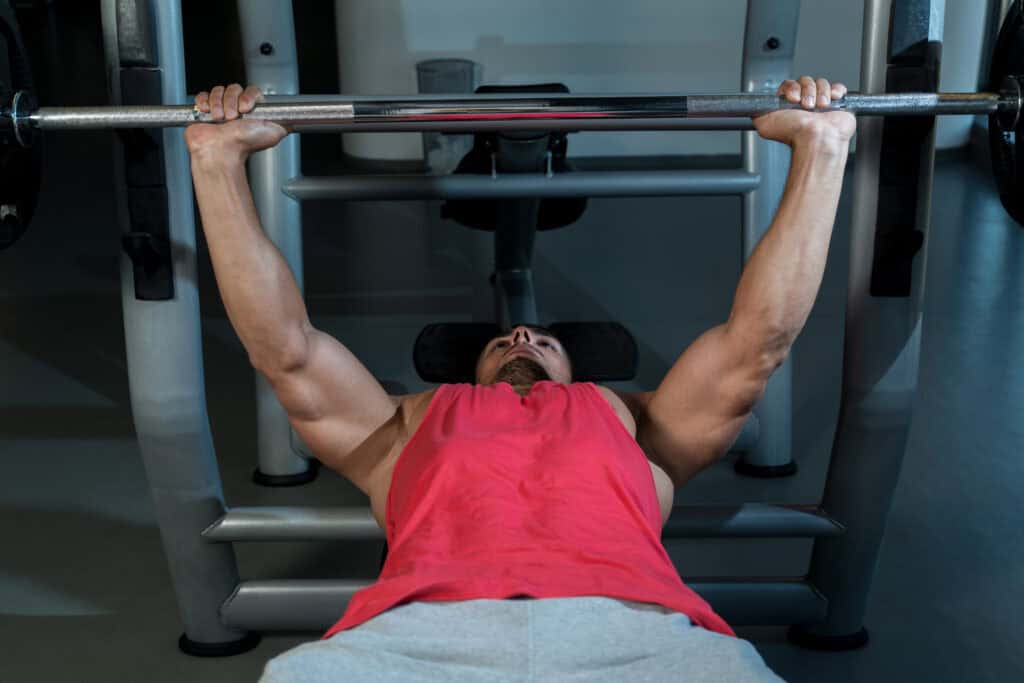When it comes to building a powerful chest, the effectiveness of different exercises varies based on the equipment you use. This article breaks down, what we believe are, the best chest exercises in four categories: barbell, dumbbell, machine, and bodyweight—supported by electromyography (EMG) studies.
1. Barbell Chest Exercise: Flat Barbell Bench Press
The flat barbell bench press consistently ranks as one of the best exercises for overall chest development. EMG studies confirm that this exercise produces high activation in the pectoralis major, particularly the middle chest. It also allows for a heavier load compared to other chest exercises, which is essential for building strength and size. Research highlights a positive correlation between a higher one-rep max in the bench press and the size of the pectoralis major.
Pro Tip: To maximize chest activation, ensure a full range of motion by lowering the bar to your chest and pressing up explosively.
2. Dumbbell Chest Exercise: Incline Dumbbell Press
For those focusing on the upper chest, the incline dumbbell press is a top contender. EMG studies show that an incline of 15 to 30 degrees optimally activates the upper chest without involving the shoulders too much. While both barbell and dumbbell presses target the chest, the dumbbell press has a slight edge in terms of increased range of motion, allowing for better muscle engagement.
Pro Tip: This exercise not only increases upper chest activation but also engages stabilizing muscles, leading to more balanced development.
3. Machine-Based Chest Exercise: Pec Deck Machine
Among machine-based chest exercises, the pec deck machine ranks the highest in terms of EMG chest activation. The unique advantage of the pec deck is its ability to isolate the chest muscles effectively by minimizing the involvement of secondary muscles like the triceps or deltoids. This isolation makes it particularly effective for hypertrophy, as it maximizes chest tension throughout the movement.
Pro Tip: It is crucial to maintain good form to prevent undue shoulder strain and focus on a full range of motion for optimal muscle contraction.
4. Bodyweight Chest Exercise: Dips
For bodyweight chest exercises, dips are unmatched in their effectiveness, particularly for targeting the lower chest. According to EMG studies, leaning slightly forward while performing dips increases the involvement of the pectoral muscles by placing the shoulders in an extended position.
Pro Tip: This movement not only works the chest but also strengthens the triceps and shoulders, making it a great compound exercise that provides overall upper body benefits. For added resistance, consider using a dip belt or weighted vest once you master bodyweight dips.
Conclusion
Building a strong chest requires incorporating a variety of exercises to target different portions of the pectoralis major. The flat barbell bench press stands out for overall strength and chest thickness, while the incline dumbbell press is ideal for upper chest development. For isolation, the pec deck machine excels at focusing tension on the chest muscles, and dips are the best bodyweight option for working the lower chest. EMG studies consistently support these exercises as some of the most effective for chest activation and muscle growth.
By incorporating these exercises into your chest routine, you can achieve balanced development and enhance strength gains. Be sure to experiment with different variations and equipment to find what works best for your body type and goals.
Scientific References
Akagi, R., et al. (2017). “Association between muscle strength and cross-sectional area of pectoralis major.” Journal of Physical Fitness and Sports Medicine. Retrieved from PubMed.
Contreras, B., et al. (2013). “EMG Analysis of Chest Exercises.” T-Nation. Retrieved from T-Nation.
Andersen, V., et al. (2014). “Comparison of barbell bench press and push-up exercise with the same external load in resistance-trained males.” Journal of Strength and Conditioning Research. Retrieved from National Center for Biotechnology Information (NCBI).
Schoenfeld, B.J., et al. (2015). “The Mechanisms of Muscle Hypertrophy and Their Application to Resistance Training.” Journal of Strength and Conditioning Research, 29(11), 2853-2864. Retrieved from ResearchGate.
Stay Strong Together
If you’re serious about building muscle and reaching your fitness goals, the Jefit app is the perfect tool to help get you there. With over 20 million downloads and more than 12 million bodybuilders using the app to track their workouts, Jefit is the ultimate strength training companion. Rated as the 2023 Best App and featured by top publications like Men’s Health, PC Magazine, and USA TODAY. Jefit boasts 42,000+ five-star ratings for its user-friendly design and comprehensive features. Whether you’re focused on protein intake, building strength, or tracking your progress, Jefit has everything you need to succeed. Download Jefit today and join millions of fitness enthusiasts transforming their bodies!
- Nutrition Trends Bodybuilders are Talking About in 2025 - November 26, 2025
- Smart Strength Training Backed by Jefit Data - November 19, 2025
- Break Through Strength Plateaus: JEFIT Guide - November 12, 2025
